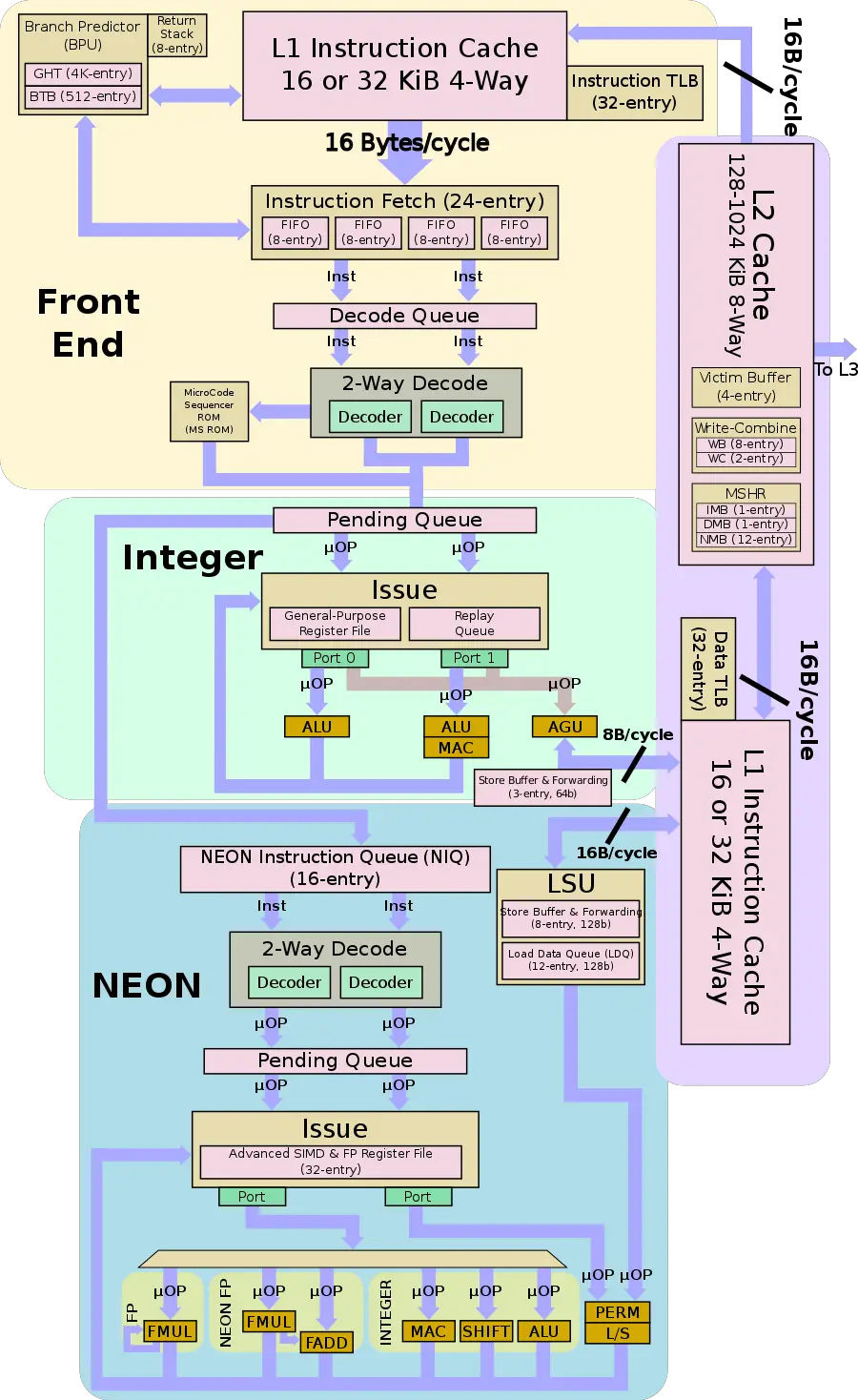(→Key changes from {{\\|ARM11}}) |
|||
| Line 48: | Line 48: | ||
* [[ARMv7]] (from [[ARMv6]]) | * [[ARMv7]] (from [[ARMv6]]) | ||
** Support for {{arm|NEON}} (ASIMD) | ** Support for {{arm|NEON}} (ASIMD) | ||
| + | ** {{arm|VFPv3}} (from {{arm|VFPv2}}) | ||
** {{arm|TrustZone}} | ** {{arm|TrustZone}} | ||
** {{arm|Thumb-2}} | ** {{arm|Thumb-2}} | ||
Revision as of 00:39, 31 December 2018
| Edit Values | |
| Cortex-A8 µarch | |
| General Info | |
| Arch Type | CPU |
| Designer | ARM Holdings |
| Manufacturer | TSMC |
| Introduction | October 5, 2005 |
| Process | 65 nm, 45 nm |
| Pipeline | |
| Type | Superscalar, Pipelined |
| OoOE | No |
| Speculative | Yes |
| Stages | 13 |
| Decode | 2-way |
| Instructions | |
| ISA | ARMv7 |
| Extensions | NEON, TrustZone, Thumb-2, Jazelle-RCT, VFPv3 |
| Succession | |
Cortex-A8 (codename Tiger) is the successor to the ARM11, a low-power performance ARM microarchitecture designed by ARM Holdings for the mobile market. This microarchitecture is designed as an IP core and is sold to other semiconductor companies to be implemented in their own chips. The Cortex-A8 was designed by the Arm Austin design center.
Contents
Compiler support
| Compiler | Arch-Specific | Arch-Favorable |
|---|---|---|
| Arm Compiler | -mcpu=cortex-a8 |
-mtune=cortex-a8
|
| GCC | -mcpu=cortex-a8 |
-mtune=cortex-a8
|
| LLVM | -mcpu=cortex-a8 |
-mtune=cortex-a8
|
One can specify NEON support using the -mfpu=neon option. Note that GCC will not generate floating-point operations for auto-vectorization constructs because NEON is not fully IEEE 754-compliant. It's possible to use -funsafe-math-optimizations to circumvent that behavior.
Architecture
The Cortex-A8 was the first application processor from the Cortex family. It is also Arm's first superscalar, dual-issue microprocessor.
Key changes from ARM11
- 65 nm process (from 90 nm)
- ARMv7 (from ARMv6)
- ARM reported 2.0 DMIPS/MHz (up from 1.2 DMIPS/MHz)
- Average IPC reported is 0.9 (based on SPECint95, EEMBC, Mediabench, and others)
- First superscalar design
- dual-issue (from single-issue)
- in-order
- 13-stage pipeline (up from 8 stages)
- Targets frequency up to 1 GHz
- First NEON implementation
- 10-stage pipeline
- Dedicated private L2 cache
Block Diagram
Memory Hierarchy
- Cache
- L1I Cache
- 16 KiB OR 32 KiB (configurable)
- 4-way set associative
- 64 B line size
- Random replacement policy
- L1D Cache
- 16 KiB OR 32 KiB (configurable)
- 4-way set associative
- 64 B line size
- Random replacement policy
- L2 Cache
- 0 KiB OR 128 KiB OR 1 MiB (configurable)
- 8-way set associative
- 64 B line size
- Optional Parity and ECC
- L1I Cache
- TLB
- ITLB
- 32-entry, fully-associative
- 4 KiB, 64 KiB, 1 MiB, and 16 MiB page sizes
- DTLB
- 32-entry, fully-associative
- 4 KiB, 64 KiB, 1 MiB, and 16 MiB page sizes
- ITLB
Licensees
Arm named the following companies as licensees.
Die
- 65 nm process
- Up to 1 GHz
- 4 mm² (core only, no NEON, L2 cache, and embedded trace)
- <= 300 mW
| codename | Cortex-A8 + |
| designer | ARM Holdings + |
| first launched | October 5, 2005 + |
| full page name | arm holdings/microarchitectures/cortex-a8 + |
| instance of | microarchitecture + |
| instruction set architecture | ARMv7 + |
| manufacturer | TSMC + |
| microarchitecture type | CPU + |
| name | Cortex-A8 + |
| pipeline stages | 13 + |
| process | 65 nm (0.065 μm, 6.5e-5 mm) + and 45 nm (0.045 μm, 4.5e-5 mm) + |
